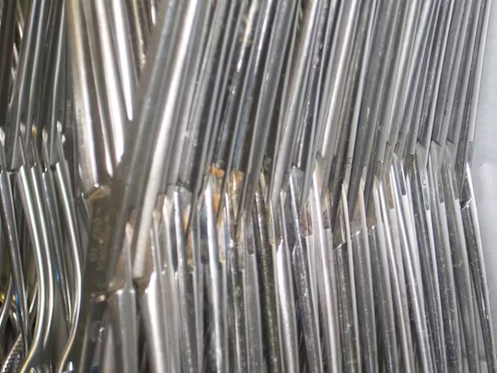By Martin Li, M.A., CRCST, CER, CIS, CHL
Figure 1 photo from online
Introduction
In the field of sterile processing, understanding the
different grades of surgical steel and the correct reprocessing methods is
crucial for maintaining instrument integrity and ensuring patient safety. This
article delves into the critical aspects of surgical steel grade selection and
reprocessing procedures, drawing on insights from both surgical device
manufacturers and SPD practices.
Understanding Stainless Steel Grades
Stainless steel is the primary material for surgical
instruments due to its resistance to rust and corrosion. There are several
grades of stainless steel used in the medical field, each offering different
properties that affect the performance and longevity of the instruments.
Austenitic Stainless Steel (300 Series)
Austenitic stainless steels, such as the 316L grade, are
widely used for implants and surgical instruments. These steels contain high
levels of chromium and nickel, which provide excellent corrosion resistance and
are non-magnetic. Grade 316L is particularly favored for its low carbon
content, which enhances its resistance to intergranular corrosion after welding.
Stainless steel 304 grade is similar to grade 316. The difference between 304
and 316 stainless steel is that 316 contains molybdenum, which enhances
corrosion resistance, while 304 does not. Still, 304 stainless steel corrosion
resistance is high, which is why 304 stainless steel tubing is common in
healthcare. [3], [5].
Martensitic Stainless Steel (400 Series)
Martensitic stainless steels, such as 420 and 440 grades,
are used for instruments requiring a sharp cutting edge, like scalpels and
scissors. These steels contain higher carbon content, providing the hardness
and strength needed for precision tools. However, they are less resistant to
corrosion compared to austenitic steels [6].
Duplex Stainless Steel
Duplex stainless steels combine the properties of austenitic
and ferritic steels, offering high strength and excellent corrosion resistance.
They are used in specific surgical applications where these properties are
required [1].
The Role of Titanium
In addition to stainless steel, titanium is frequently used
for surgical instruments and implants, especially in scenarios where
non-magnetic properties are essential. Titanium is biocompatible and offers
superior corrosion resistance, making it ideal for long-term implants and
specialized surgical tools [2].
Manufacturing Process of Surgical Instruments
The manufacturing of surgical instruments is a multi-step
process that involves forging, machining, heat treatment, and polishing. The
quality of the stainless steel used is crucial at each stage. Premium-grade
instruments are crafted from high-quality materials and undergo rigorous
quality control to ensure they meet the necessary standards for surgical use [1].
Quality Control
Quality control is integral to the manufacturing process. It
includes verifying the material composition, ensuring the precision of
machining, and performing corrosion resistance tests. Instruments that pass
these stringent checks are then marked as medical-grade, suitable for use in
surgical settings [4].
Reprocessing Surgical Instruments in SPD
Reprocessing reusable surgical instruments according to the
manufacturer’s Instructions for Use (IFU) is essential for maintaining their
functionality and safety. This process involves several stages: cleaning,
disinfecting, sterilizing, and inspecting the instruments to ensure they are
safe for reuse.
Cleaning
Effective cleaning is the first step in reprocessing.
Instruments must be thoroughly cleaned to remove blood, tissue, and other
contaminants. This can be done manually or using automated washers, following
the guidelines provided by the manufacturer [6].
Disinfecting
After cleaning, instruments must be disinfected to kill any
remaining microorganisms. This step is critical for preventing infections and
ensuring patient safety. Disinfection can be achieved using chemical solutions
or high-temperature steam or water [2].
Sterilizing
Sterilization is the final step in reprocessing. Instruments
are subjected to high temperatures or chemical sterilants to eliminate all
forms of microbial life. The most common methods include steam sterilization
(autoclaving), ethylene oxide gas, and hydrogen peroxide plasma [6].
Inspection and Packaging
Once sterilized, instruments must be inspected for any signs
of damage or wear. Damaged instruments should be removed from service to
prevent potential harm to patients. Instruments that pass inspection are then
packaged in sterile barriers to maintain their sterility until use [2].
Practical Considerations for SPD Professionals
As an SPD educator, it is crucial to train staff on the
proper maintenance and handling of surgical instruments. This includes
understanding the specific requirements of different steel grades, following
the manufacturer’s IFU, and implementing best practices for reprocessing.
Training and Education
Continuous education and training are vital for SPD staff.
Regular training sessions on the latest reprocessing techniques, updates on
manufacturer guidelines, and hands-on workshops can help maintain high
standards of instrument care [4].
Regular Inspections and Maintenance
Regular inspections and maintenance of surgical instruments
are essential to ensure their longevity and performance. SPD professionals
should be trained to identify signs of wear and corrosion and take appropriate
actions to mitigate these issues [5].
Conclusion
Understanding the right surgical steel grade and following
the manufacturer’s IFU for reprocessing are critical for ensuring the
durability and performance of reusable surgical instruments. By understanding
these factors, SPD professionals can enhance surgical outcomes and maintain
high standards of patient care. The role of an SPD educator is to impart this
knowledge to the staff, ensuring they are equipped with the skills and
understanding necessary to handle surgical instruments effectively and safely.
References
1. pfiedlereducation.com - Surgical Grades of Instruments: The
Manufacturing Process
2. Llewellyn, B (2023). A Comparison of Surgical
Tool Materials. https://trocarsupplies.com/
3. Tannoury, Chadi. et
(2007). Surgical Stainless Steel. sciencedirect.com
4. Kovach, S (2022). Understanding your P's,
Q's, and S's in instrument care & handling. hpnonline.com
5. essentracomponents.com - What is surgical steel? The role of
stainless in healthcare
6. steris.com - Cleaning and Disinfecting Surgical Instruments






In the field of sterile processing, understanding the different grades of surgical steel and the correct reprocessing methods is crucial for maintaining instrument integrity and ensuring patient safety. This article delves into the critical aspects of surgical steel grade selection and reprocessing procedures, drawing on insights from both surgical device manufacturers and SPD practices.
ReplyDelete